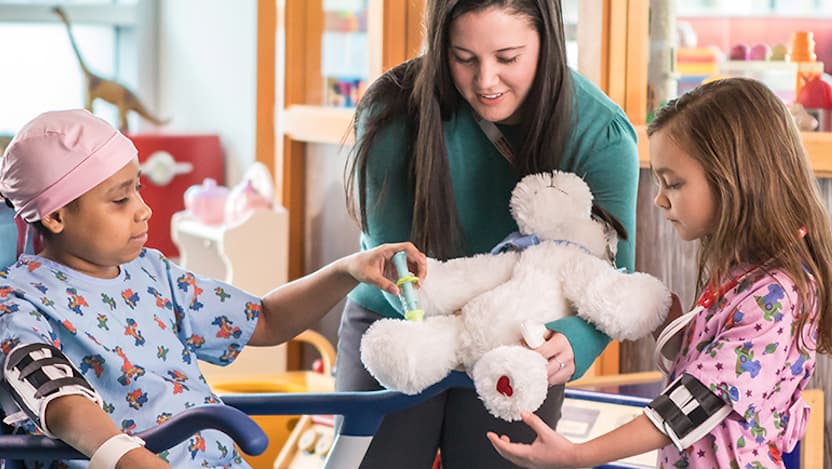Child life specialists help kids through the hospital experience

Being rushed to the hospital as an adult can be scary; for a child, it can be traumatizing. That's why child life specialists are there every step of the way to keep children calm and educated on the road ahead.
Ashlee Burgess, a child life specialist at the University of Chicago Medicine Comer Children’s Hospital, explains their role during a child’s hospitalization.
What do child life specialists do?
Child life specialists are nationally certified professionals whose experience is primarily in child development. We seek to find ways to decrease the anxiety and trauma that children face when they come to the hospital, whether it’s through play, conversation, distraction or relaxation techniques. We also try to find ways to give children a voice in their health care, like choosing which finger their pulse oximeter goes on, whether they want to watch or look away during their procedure, and allowing them to choose what will be helpful during their stay.
What role does a child life specialist play in the ER?
My job is to create a quick, safe relationship with the patient to decrease their fears of the unfamiliar things and faces around them. I introduce myself, and let them know my job is to explain why the doctors are doing what they’re doing. In the trauma bay, there are multiple people and departments – pharmacy, surgery doctors, emergency room department doctors, and radiology — in the room, so you can only imagine how stressful that can be on a child. We also help children and families create coping plans: Who will be in the room to support the kid, what will the child focus their attention on, and how will the child keep calm and relaxed.
What do the first minutes look like when a child arrives to the ER as a trauma patient?
In a trauma setting, they have at least six strangers standing above and around them. They are hearing multiple voices tell them what to do and what not to do. It’s all so overwhelming! The trauma team will assess the child’s cognition and function by seeing if kids can wiggle their toes and fingers, can answer questions appropriately, and they will look at their body for sources of pain. It all happens in a very quick span of time.
What do you do to make the experience less traumatizing?
Child life specialists use a lot of play to teach kids why they are here in the hospital. Play is the language of the child and it is universal, so bringing play into the hospital makes the scary and unfamiliar space a little more normal and fun. In general, we will find ways to integrate information on why they are here and then teach them about procedures or experiences that they might be afraid of. This means we may give them medical tools to play with that will be used on their body later on, such as a saline syringe to use as a squirt gun. We reassure the child that they are safe and that the doctors and nurses are here to help their bodies feel better.
What role does child life play in supporting parents?
When children come in as trauma patients, parents wait outside the trauma bay and the child life specialist is with the patient. We have the special opportunity to connect with parents and tell them what’s been going on in the trauma room and how their child is coping. Giving concrete information that is unique to their child helps parents feel comforted. We try to involve parents and caregivers in whatever way possible to help facilitate a sense of normalcy.
